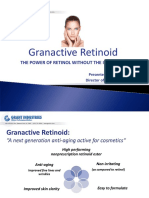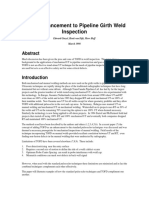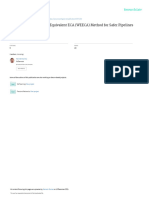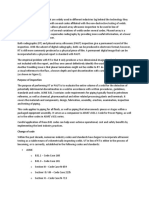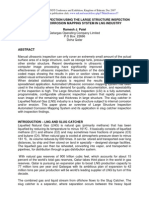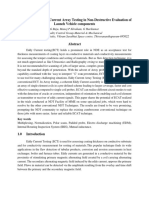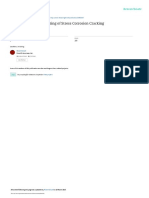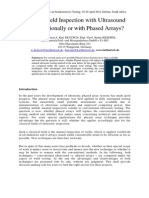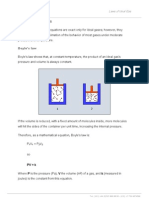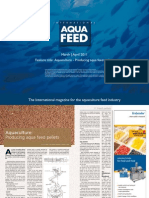27 251s PDF
27 251s PDF
Uploaded by
Durgamadhaba MishraCopyright:
Available Formats
27 251s PDF
27 251s PDF
Uploaded by
Durgamadhaba MishraOriginal Title
Copyright
Available Formats
Share this document
Did you find this document useful?
Is this content inappropriate?
Copyright:
Available Formats
27 251s PDF
27 251s PDF
Uploaded by
Durgamadhaba MishraCopyright:
Available Formats
[ 27 2 p.
251s-256s (2009)]
Automated Ultrasonic testing of Pipeline Girth Welds, its Present Status
and Future Developments
by Cesar Buque, Jan van der Ent, Niels Prtzgen, Marcel Blinde, Tjibbe Bouma, ISHIDA Tomoyoshi
Mechanized or Automated Ultrasonic Testing of pipeline girth welds is now in common use in the on - and offshore industry. Automated
ultrasonic testing (AUT) is globally seen as more than just an alternative to the standard radiographic inspection technique not only because it
does not poses safety hazards but also because it is faster, more reliable and has better detection capabilities of critical Lack of Fusion defects in
pipeline girth welds. One of the reasons to use the AUT technique is due to its possibility to use acceptance criteria which are based upon ECA
(Engineering Critical Assessment) instead of the so-called "Good Workmanship". Usually the AUT systems are mounted on a band strapped
around the pipe. From the weld, ultrasonic data is collected from which the defect sizes and positions can be determined by experienced
operators using dedicated software algorithms. This paper discusses the RTD Rotoscan system, which is the first worldwide AUT inspection
system for new construction pipeline girth welds. The principles of AUT, the conventional RTD Rotoscan as well as the RTD phased array
Rotoscan and its advantages in comparison with conventional (multi probe) AUT are discussed. Furthermore challenges regarding the use of
AUT on Austenitic welding having a corrosion-resistant alloy layer are presented. This paper describes also latest improvements made on AUT
during the last years in order to optimize inspection philosophy and minimize the system's "Uncertainties". In addition a brand new method,
RTD IWEX, is briefly described that allows the detection and sizing of weld imperfections in 3D.
Key Words: AUT, girth weld, pipeline, Phased array, CRA, weld inspection, austenitic weld
through-thickness height.
1. Introduction
The latest RTD Rotoscan (Fig. 2) makes also use of Phased
Array technology which gives the system advanced possibilities
The use of AUT to test pipeline girth welds during pipeline
and flexibility to accurately detect and size imperfections with
construction has increased substantially around the world since
different orientations and locations in the girth welds. In addition,
the 1980's when Applus RTD introduced the worldwide first AUT
all RTD Rotoscan systems make use of specifically designed
system (the "RTD Rotoscan"). This was partly driven by the
detection and sizing algorithms allowing not only compliance
progress in flaw sizing and recording which made it possible to
with code and customer requirements but also to achieve a very
use so-called rejection/acceptance criteria for weld defects based
high Probability Of Detection (POD), together with a low false-
on fracture mechanics, instead of good workmanship criteria as
call rate (FCR).
common practice in radiography.
The RTD Rotoscan is also optimized for the automated
The development and actual use of such modern Engineering
inspection of pipeline girth welds consisting of anisotropic
Acceptance (ECA) Criteria, first in Canada and later also in other
welding materials (e.g. austenitic) in combination with a CRA
countries, supported the introduction of AUT into the industry.
layer (Corrosion Resistant Alloy). Such austenitic girth welds
RTD, after having been the first company to offer these services
cannot be inspected by conventional ultrasonics, and have to be
(cf. Fig. 1), was soon followed by other providers. Another
examined by non-conventional angle beam compression wave /
acceleration factor was the introduction of transit-distance C-scan
creep wave technique. The present paper will briefly address this
mapping in 1992 which enabled the system to cope with most
type of inspections.
existing ultrasonic procedures and acceptance criteria, because of
Despite the lack of international standards, ApplusRTD's
its capability to visualize the weld geometry such as the root
penetration and weld cap reinforcement in order to eliminate false
call rate and to a certain extent, quantify volumetric defects.
Moreover, the integrated Time-of-Flight Diffraction (ToFD)
function, together with the amplitude-based, software-aided,
sizing capability provides accurate, state-of-the-art data on defect
*Received on 13 June 2008
**
Applus RTD Group, 3046 NC Rotterdam, The
Netherlands
***
Applus RTD IPS, 3046 NC Rotterdam, The Netherlands
****
Applus RTD Singapore, Singapore
*****
Applus RTD KK, Tokyo, Japan
Fig. 1
World wide first AUT system for girth welds: RTD
Rotoscan in 1959.
252s
Automated Ultrasonic Testing of Pipeline Grith Welds
Fig. 3 Schematic illustration of a girth weld divided into four zones.
Applus RTD, well known as the pioneer in the AUT market
for girth weld inspection, introduced and patented the zonal
concept already in 1952. Since then this concept has now become
Fig. 2 The most recent RTD Phased Array Rotoscan for AUT on
pipeline girth welds. This unit was first introduced to the
market in August 2008. The phased array probes emulate
the multi-zone inspection approach as required by most
codes and standards.
the world standard and has been described in a number of codes
and standards.
The amplitude in a channel corresponding with a particular
zone, indicates a possible defect in that zone.
For each zone on both sides of the weld a different transducer
system has been qualified in various countries for different
is needed in different configurations such as pulse echo, tandem
individual customers and for a variety of weld processes, pipe
and ToFD. The number of transducers required for the inspection
diameters, and wall thicknesses, and has demonstrated its on- and
of a weld is related to the wall thickness, weld bevel configuration
offshore capabilities even under harsh field conditions. World-
and the number of inspection zones and in some cases it can be
wide applications proved that, contrary to expectations, ultrasonic
easily be more than twelve.
inspection does not lead to higher weld repair rates than
The inspection system is often calibrated on flat bottom
radiography. Between early 1989 and the present, over 30,000km
holes/and or notches, whereby each zone has a corresponding flat
of pipeline (representing over 2,000,000 welds) have been
bottom hole. The echo caused by a flat bottom hole is set at a pre-
inspected with the RTD Rotoscan alone.
determined value. Calibrating such a system is time consuming,
Development work continues to increase sizing accuracy
even further. Applus RTD just finalized the design and proto type
because each transducer must be optimized, both its exact location
with respect to the weld and its sensitivity.
of a matrix phased array system with 1024 channels. The
For optimum defect sizing, the ultrasonic beams are set such
advantages of such a system are going to be presented in this
that they hit an embedded defect perpendicularly, thus allowing
paper. Applus RTD's latest innovation ("RTD IWEX") is the
maximum reflection. AUT of girth welds generally assumes that
future of AUT. This technology allows a much higher detection
imperfections/defects are have the same orientation as the weld
and sizing accuracy without the use of reference blocks (also so-
bevel orientation, which is not always the case.
called calibration blocks). The principles of this revolutionary
technology are going to be briefly discussed in this paper.
Therefore, in conventional AUT systems each part of the
weld is interrogated by a matched angle beam for the particular
zone and weld preparation it is intended for, offering best possible
2. Conventional AUT of Girth welds
sizing and ensuring a maximum POD.
A known potential problem in mechanized ultrasonic
In AUT applications an automated scanning system carrying
inspection is that, especially in the root region, it is difficult to see
a set of ultrasonic transducers at both sides of the weld is rapidly
the difference between geometry and defect signals. In RTD
rotated in a controlled manner for volumetric weld inspection in
Rotoscan this is solved by digitization of signals from the root,
one single scan around the circumference.
whereby these signals are displayed in the form of a C-scan map..
The transducer arrangement is designed on the basis of the
This enables the use of the geometry of the weld as a reference in
weld bevel configuration, in such a way that all defects that can be
interpretation, just like one does in radiographic inspection.
expected are detected with maximum probability and with
However it has to be emphasized that in case of small root
minimum false call rate. To achieve this, the weld thickness is
penetration or no penetration at all it is still very difficult to
traditionally divided into small zones of typically 2-3 mm in
distinguish between geometry and defect signals in the root
vertical height (Fig. 3). In this zonal discrimination concept each
region.
single zone is covered by an optimized separate transducer or
The same goes for detection and quantification of porosity.
transducer combination. For more specific details on this subject
Since porosity gives mostly only minor reflections, the only
the reader is referred to .
accurate way to achieve a reliable detection of porosity is by
1)
27 2009 2
253s
means of pattern recognition. The use of C-scan mapping,
supported by ToFD, makes this possible (Fig. 4).
The use of ToFD technique is important. ToFD is used as a
"safety net" in detection, and also for sizing and positioning of
3. Phased AUT on Girth Welds
3.1 What is Phased Array
defects in through thickness direction. Some codes already
As it can be deducted from the Fig. 5 Phased array
require the use of ToFD in mechanized inspection of pipeline
technology is a technical solution for generating and receiving
girth welds, in addition to pulse echo technique.
ultrasound using an ultrasonic transducer consisting of an array of
The use of computers for data acquisition and storage not
elements that can be individually pulsed simultaneously or one
only enables a coherent display of signals, highly comprehensible
after other following a certain pre-determined sequence. Most
for the operator, but also opens the way to automatic
details of ultrasonic inspection remain unchanged. For example
interpretation. The signals from the weld are in this case directly
for an ultrasonic inspection the ultrasonic transducer is selected
compared to the requirements of the applicable code or standard
according to the desired ultrasonic beam angle, focal distance and
in terms of defect amplitude, length and through thickness height.
scan pattern for that specific inspection. Therefore very often
Such automatic interpretation software can take over a lot of the
different sets of transducers are required making the inspection
routine work from the operator, thus avoiding subjective errors.
costly. In the case of phased array technology a large variety of
In the case of RTD Rotoscan the software also allows for
inspection parameters (beam angle, focal distance and scan
automatic generation of site reports, thus avoiding typing errors
pattern) can be achieved using the same transducer and by
and increasing feedback speed.
applying time delays in the pulsing sequence. The time delays
Nowadays RTD Rotoscan is used efficiently in a number of
values are calculated using time-of-flight from the focal spot, and
onshore and offshore pipe construction applications. Specific
the scan assembled from individual "Focal Laws". Also,
applications for AUT systems like Rotoscan are:
modifying a prepared set-up is quick in comparison with
* Cross-country and lay barge projects
* Riser and riser bundle manufacture
* Steel catenary risers (SCR's)
* Pipe with CRA layer
* Different types of steels including austenitic steels and 9%
Nickel steels
* etc.
physically adjusting conventional transducers.
3.2 Advantages of Phased Array technology in AUT
The use of array technology in girth weld AUT offers many
advantages and potentials when compared with conventional
AUT. For example, in conventional AUT of pipeline girth welds,
a new transducer set has to be composed in hardware for each new
With an inspection cycle time of usually a few minutes,(
application (i.e. combination of wall thickness and weld
cycle time consist of calibration ; inspection of weld and transport
geometry). In case of phased array this job preparation is reduced
time in case of on-shore application) the conventional RTD
to optimization of the probe system's main beam characteristics
Rotoscan is of proven value to the offshore and onshore industry
(beam angles, beam widths and focal points) by means of
as the NDT activities are removed from the critical path, saving
software settings (Fig. 5).
e.g. barge days. Furthermore the industry benefits greatly from
When phased array technology is used rather than fixed
the instantaneous availability of real-time inspection data, as
transducers, the beam characteristics can be controlled and thus
immediate feedback to welding crews improves field monitoring
optimized with one system and performed by one linear phased
of the welding process, consequently reducing overall repair rates.
Fig. 5
Fig. 4
Screenshot with a typical view on a situation where
porosity and lack of fusion were detected. In this
particular figure ultrasonic indications caused by porosity
are clearly visible.
Phased array simulation. Using phased array system the
only changes needed on the transducer setup are made by
software settings. Beam angle, beam spread, beam width
and beam directivity can thus be easily programmed for
different jobs without physically changing the transducer
setup.
254s
Automated Ultrasonic Testing of Pipeline Grith Welds
array transducer, without changing the hardware. When the linear
generally austenitic welds. Ultrasonic inspection of such welds is
phased array contains enough elements, configurations for
difficult and requires special attention from AUT 245). Main
multiple element transducers such as tandem transducers can be
reasons for that are the coarse grain structure of austenitic welds
formed in this way. The flexibility offers operational benefits and
and the strong dependence of the sound velocity on the
reduction in preparation and inspection time.
crystallographic grain orientation which in combination result in
Calibration of a phased array system can be done with
strong ultrasonic reflections (Fig. 6).
software settings. The linear phased array is placed on a fixed
Compression waves suffer significantly less from these
distance from the centre line of the weld. The signals can be
phenomena than shear waves (Fig. 6) which inevitable leads to the
optimized without physically moving the transducer, which is the
use of focused angle beam compression and creep wave probes
case in a conventional system. Preparing and calibrating the
instead of shear wave probes.
phased array system for the weld inspection, therefore, consumes
The AUT inspection set-up for austenitic welds is similar to
less time than in the case of a conventional system. Furthermore,
the standard inspection configuration for ferritic girth welds in
rather than applying a large number of individual probes a phased
that the wall thickness is divided into a number of depth zones.
array system only requires one probe at either side of the weld. In
The inspection philosophy however is different as the selected
addition to the two phased array transducers, two probes for the
probes are not dictated by the weld bevel configuration (as for
TOFD function are necessary. Since ToFD usually uses a higher
AUT of ferritic girth welds), but are designed to minimize
frequency than pulse-echo does, ApplusRTD Rotoscan has the
reflections out of the anisotropic weld structure or interface
ability to use separate ToFD probes rather than use the phased
between weld and parent metal that could interfere with the
array probes for ToFD. Dependent on the application in some
inspection result interpretation.
cases a set of two extra probes is added to detect transverse
defects.
3.3 Phased Array technology in AUT of girth welds
Using linear phased arrays, the number of transducers can be
drastically reduced. With one pair of linear phased array
transducers, all configurations required can be made to inspect all
Instead of the traditional shear wave, dual crystal focused
angle beam compression waves and creep wave probes are used to
enable the full penetration of ultrasonic waves through the weld
volume, not hampered by the structure of the involved dissimilar
metals and austenitic coarse grain size structure.
4.2 AUT data on CRA: data evaluation and presentation
zones from both sides. Instead of a separate transducer, a
For the ultrasonic inspection of austenitic welds and CRA
different set of delay times is used for each configuration. A
layers, having dissimilar interface(s) and anisotropic material
normal pulse echo configuration will be obtained when a group of
structure (compare Fig. 7 and Fig. 8), the standard AUT pulse
active elements is used for both transmitting and receiving. An
echo presentation is not adequate to present all the essential
active group of elements (typically up to 32) can be multiplexed
features required for the correct interpretation of the AUT CRA
along an entire array (with typically up to 128 elements) enabling
inspection channels 2) . As illustrated in Fig. 9 the used
the index point of the beam to be shifted. A tandem configuration
compression wave has to pass the primary and coincidence
is formed when the reflected beam from one active group is
interface between the carbon steel and the austenitic weld
received by another active group elsewhere on the array. The
material, identified with the green and red borders. In order to
receiving group may also partially overlap the transmitting group,
identify the Primary and Coincidence interface position, the RTD
thus eliminating limitations caused by physical crystal dimensions
in conventional transducers.
The PRF (pulse repetition frequency) of a PA system is
identical to that of the conventional systems. This ensures the
same high measuring point density for a full inspection sequence
(cycle), maintaining the same scanning speed. During a cycle of
sequences all probe functions as previously programmed are
activated to provide full volumetric weld cross section coverage.
4. AUT on pipelines with Corrosion-Resistant Alloy layer
4.1 Preliminary considerations
Pipelines with corrosion-resistant alloy layers inside have
Fig. 6
Typical ultrasonic reflections as caused by the grain
morphology when inspecting austenitic weld using
conventional shear waves (top image) and when using
compression waves (bottom image).
27 2009 2
255s
Rotoscan result presentation has been enhanced with an image
the screen and to be able to correlate / evaluate the indications
format being referred to as "All channels mapping" presentation.
present at the primary and /or coincidence interface within the
In this context "All channels mapping" has to be understood as
weld volume to increase the confidence level. This technique is
stacked C-scans in color, with each c-scan originating from a
called "primary/coincidence technique".
certain transducer focused to a certain area of the weld
configuration.
With the function "all channel mapping" all ultrasonic wave
form information (A-screen dynamic range 0-100% FSH) derived
The "all-channels mapping" facility within the AUT system
from inspection gates, are digitized with a high sampling
software is an essential feature to visualize the inspection result on
frequency. Recorded amplitude and corresponding transit
distance are converted into a color pattern. In this presentation a
coherent display is obtained showing the defect position(s) and
geometrical features (e.g. noise out from the interface) in relation
to the weld centerline. For more details on this the reader is
referred to van der Ent et al.2).
5. AUT on pipelines with Corrosion-Resistant Alloy layer
It is well-known that all welded structures will always
contain different types of imperfections. It is also known that not
all flaws necessarily affect structural integrity or service
Fig. 7 Light microscopic image showing an austenitic girth weld
in CRA (metallurgical bonded) clad pipeline (austenitic
welding material having coarse grains).
performance of a welded structure, in this case newly welded
pipelines. These facts are implicitly recognized by most welding
fabrication codes which based on different so-called Engineering
Critical Assessment criteria (ECA) specifying the level of
acceptance of imperfections in new girth welds.
Quantitative characterization of weld integrity based on ECA
considerations has conclusively proven that knowledge on
accuracy with which weld imperfections can be sized, particularly
in terms of defect height and defect orientation is of paramount
importance 2). To achieve the required sizing accuracy new
inspection concepts combined with new physical algorithms are
needed. Two of the most prominent methods being close to
market introduction are presented in the paragraphs below.
Fig. 8 Light microscopic macro showing a ferritic girth weld in
carbon steel pipeline. In comparison with Fig. 7 it can be
seen that in this case the grain structure is much finer.
5.1 The RTD Matrix Phased Array
The development of the newest generation of RTD Rotoscan,
the RTD Matrix Phased Array Rotoscan, has just been finalized
and is now entering the validation phase in the USA (Fig. 10).
This solution, consisting of 1024 PA channels, has the major
advantage to focus and to steer the beam in two different
directions, allowing a volumetric insonification of the
imperfections and/or defects. A girth weld can thus be inspected
using a variety of probe angles and hence accurate sizing of tilted
and skewed defects is possible and significantly improved.
Fig. 9
The CRA inspection technique makes use of specially
designed compression wave probes to avoid reflections
from the anisotropic welding structure. As can be seen
from the figure the compression wave has to pass the
primary and coincidence (opposite) interface between the
carbon steel and the austenitic weld material, identified
with the green and red borders.
5.2
Future generation AUT: quantitative 3D imaging of
defects
To date, the performance of all ultrasonic technologies used
in the oil & Gas industry depend on the quality of the so-called
calibration blocks, and because of that the interpretation of the
256s
Automated Ultrasonic Testing of Pipeline Grith Welds
Fig. 11 Example of the imaging and sizing accuracy that can be
achieved with RTD IWEX. The three bore holes on the
left sample have a 0.5 mm diameter. The center of the
holes are separated 1mm and 1.5 mm respectively. On the
IWEX image (right side) all three bore holes are clearly
visible3).
6. Conclusions
After many years of persistent pioneering and marketing by
Fig. 10
The RTD Matrix Phased Array unit consisting of 1024
channels (top image). The image below illustrates the
flexibility that can be achieved while using Matrix
Phased Array technology. The matrix-like arrangement of
PA elements enables the operator to steer side ways and
focus the beam in the lateral direction
ApplusRTD, AUT of pipeline girth welds is now offered by a
number of NDT providers as a worldwide service and has reached
a high level of professionalism. Primary key factors in the
ultimate success of pipeline AUT became its capability to
discriminate between defects and geometry indications, to detect
results achieved is not straight forward, and special interpretation
and quantify porosity and to use ECA criteria. These three factors
skills and special training (Level III) are needed in order to be
(including mapping of weld geometry such as root penetration and
able to read and interpret the results.
cap reinforcement) helped to avoid false calls, thus reducing the
Furthermore the most used ultrasonic technologies in use
number of unnecessary repairs. AUT practices, now used by all
have strong limitations. For example testing using pulse echo
AUT providers, are still based on the zonal concept patented by
technique and ToFD has have been proven to sufficiently reliable
ApplusRTD in 1952. Developments in pipeline AUT are still in
to assess weld integrity.
However, quantitative defect
progress. Defect detection, characterization and sizing will, in the
characterization with pulse-echo remains challenging because the
future, be further enhanced by efficient use of array technologies,
signal amplitude caused by the reflection at the defect is very
like IWEX technology.
dependent of defect orientation. TOFD has good sizing
Acknowledgments
capabilities, but only very limited capabilities in flaw
characterization. Data display is not straightforward and require
operator skill and experience. A better and more reliable
The authors would like to acknowledge the pre-work
ultrasonic inspection would be achieved if a methodology would
performed by Jan De Raad, Frits Dijkstra and few others which
be used that allows direct imaging of defects. Such a technology
ensured that this paper could be made in the required quality.
is RTD IWEX (Inverse Wavefield EXtrapolation). The physical
References
basis of this new imaging process is the Rayleigh II integral for
back propagation which gives the possibility to extrapolate a wave
field from known values at a certain surface to any location in
space. The principles of IWEX are discussed in detail in3).
The potential of IWEX for ultrasonic testing of steel
components has been demonstrated by several examples by which
2D and 3D images of embedded and surface defects were made
(Fig. 11). The investigations have shown that location, shape,
orientation and height of the defect are imaged with high
accuracy. The interpretation of the results is straightforward,
making the use of reference blocks superfluous .
3)
1)
2)
3)
4)
5)
A. De Sterke. NDT, 74 conference, Lacenster, (1974).
J.van der Ent. 12th Asia pacific conference (2006).
N. Prtzgen. PhD Thesis. TU Delft, Netherlands (2007).
F. H. Dijkstra and Jan de Raad, Duplex Conference in Maastricht
(NL), Manuscript 106 (1997).
Dutch patent registrated under nr: 1024726, PCT/NL2004/000874,
(2005).
Email contact:
* Dr. Cesar Buque, email: cesar.buque@applusrtd.com
**** Tomoyoshi Ishida; email: tishida-isc@tempo.ocn.ne.j
You might also like
- Chapter 1 Capstone Case: New Century Wellness GroupDocument4 pagesChapter 1 Capstone Case: New Century Wellness GroupJC100% (8)
- PAUT - Full Notes PDFDocument118 pagesPAUT - Full Notes PDFRamesh mudunuri100% (5)
- Granactive Retinoid (Grant Industries)Document19 pagesGranactive Retinoid (Grant Industries)Rizqi AmaliyahNo ratings yet
- Quiz Behavioral ScienceDocument91 pagesQuiz Behavioral ScienceMedShare92% (13)
- PA & ToFD In-Lieu of RTDocument14 pagesPA & ToFD In-Lieu of RTsnndhkNo ratings yet
- Ultrasonic Inspection of Pressure Vessel Construction Welds Using Phased ArraysDocument17 pagesUltrasonic Inspection of Pressure Vessel Construction Welds Using Phased ArraystbmariNo ratings yet
- 7 GinzelDocument12 pages7 GinzelMahade Hasan Dipu100% (1)
- Protection of HT & L T TransformerDocument33 pagesProtection of HT & L T TransformerMrunal SalveNo ratings yet
- TOFDDocument14 pagesTOFDaliextoma100% (1)
- PAUT - Phased Array and ToFD - V - Radiography PDFDocument14 pagesPAUT - Phased Array and ToFD - V - Radiography PDFdarouich100% (1)
- Phased Array and ToFD - V - Radiography PDFDocument14 pagesPhased Array and ToFD - V - Radiography PDFdarouich100% (1)
- Examination of Heavy Wall Pressure Vessel WeldsDocument8 pagesExamination of Heavy Wall Pressure Vessel WeldsDurgamadhaba Mishra100% (2)
- PAUT - Full NotesDocument118 pagesPAUT - Full NotesRamesh mudunuri80% (5)
- Guided Wave Testing For Touch Point CorrosionDocument7 pagesGuided Wave Testing For Touch Point CorrosionkhanhtruongNo ratings yet
- Phased ArrayDocument13 pagesPhased ArrayCemal NergizNo ratings yet
- 02 A 06 de Junho de 2003 / June 2 To 6 2003 Rio de Janeiro - RJ - BrasilDocument16 pages02 A 06 de Junho de 2003 / June 2 To 6 2003 Rio de Janeiro - RJ - Brasilfranklin84No ratings yet
- TOFDDocument10 pagesTOFDDavood Mohammad Nejad100% (1)
- Defect Sizing in Pipeline Welds - What Can We Really AchieveDocument15 pagesDefect Sizing in Pipeline Welds - What Can We Really AchieveDeeNo ratings yet
- Phasor XS Flange Face PaperDocument32 pagesPhasor XS Flange Face PapervrapciudorianNo ratings yet
- Dacon AndtDocument30 pagesDacon AndtCepi Sindang Kamulan100% (1)
- NDT Phased Array Ultrasonic TestingDocument54 pagesNDT Phased Array Ultrasonic TestingDeepak100% (2)
- Ultrasonic Testing of Pipeline Girth WeldsDocument4 pagesUltrasonic Testing of Pipeline Girth WeldsManoj Kumar InsulkarNo ratings yet
- TOFD Enhancement To Pipeline Girth Weld Inspection: Edward Ginzel, Henk Van Dijk, Merv Hoff March 1998Document12 pagesTOFD Enhancement To Pipeline Girth Weld Inspection: Edward Ginzel, Henk Van Dijk, Merv Hoff March 1998Islam FawzyNo ratings yet
- Mehmet Cagirici Department of Metallurgical and Materials Engineering, METU, 06800 Ankara, TurkeyDocument5 pagesMehmet Cagirici Department of Metallurgical and Materials Engineering, METU, 06800 Ankara, TurkeyErickNo ratings yet
- Workmanship Equivalent ECA (WEECA) Method For Safer Pipeline Welds (Tommy Ngai Kenneth Gomez McDermott OPT 2020) - GOODDocument21 pagesWorkmanship Equivalent ECA (WEECA) Method For Safer Pipeline Welds (Tommy Ngai Kenneth Gomez McDermott OPT 2020) - GOODLuckyNo ratings yet
- Phased Array Pipeline Zone Discrimination InspectionDocument4 pagesPhased Array Pipeline Zone Discrimination InspectionCepi Sindang KamulanNo ratings yet
- 1 03 14Document9 pages1 03 14koib789No ratings yet
- Ultrasonic Emats For Weld InspectionDocument3 pagesUltrasonic Emats For Weld InspectionWigand JuniorNo ratings yet
- Phased Array in Lieu of RadiographyDocument4 pagesPhased Array in Lieu of RadiographyreiazhNo ratings yet
- ISO 9001 2015 TrainingDocument242 pagesISO 9001 2015 TrainingDurgamadhaba MishraNo ratings yet
- Mfec 1Document14 pagesMfec 1Ronny AndalasNo ratings yet
- Handheld Sizing StressDocument18 pagesHandheld Sizing StressAntonio PerezNo ratings yet
- General Phased Array Questions PDFDocument7 pagesGeneral Phased Array Questions PDFMarcus Antonius100% (1)
- Automated Ultrasonic TestingDocument11 pagesAutomated Ultrasonic TestingErick100% (1)
- Qualification Process For Phased Array UT Using DNV RP-F118Document12 pagesQualification Process For Phased Array UT Using DNV RP-F118aztec20100% (1)
- Accurate Defect Sizing Using Phased Array and Signal ProcessingDocument10 pagesAccurate Defect Sizing Using Phased Array and Signal ProcessingMalolan VasudevanNo ratings yet
- Codes For Automatic Ultrasonic Testing (AUT) of Pipeline Girth WeldsDocument18 pagesCodes For Automatic Ultrasonic Testing (AUT) of Pipeline Girth WeldsjangdiniNo ratings yet
- Flaw Detection and Characterization in Welded Samples Used For Ultrasonic System QualificationDocument6 pagesFlaw Detection and Characterization in Welded Samples Used For Ultrasonic System Qualificationcal2_uniNo ratings yet
- Importance of NDTDocument10 pagesImportance of NDTLalit Bom MallaNo ratings yet
- Ultrasonic Examination Part 2Document4 pagesUltrasonic Examination Part 2JlkKumarNo ratings yet
- Ultrasonic oDocument8 pagesUltrasonic oDiego Alfonso Godoy PerezNo ratings yet
- Paper InspectingSeamlessPipeWeldsofVariableWallThic PDFDocument14 pagesPaper InspectingSeamlessPipeWeldsofVariableWallThic PDFbrocolinoNo ratings yet
- 0544 11th Icnde Paper - Implementation of Special Pa Ut Techniques For Welds in Thick Wall Components - 2015Document10 pages0544 11th Icnde Paper - Implementation of Special Pa Ut Techniques For Welds in Thick Wall Components - 2015Rupam BaruahNo ratings yet
- Portable Phased Array ApplicationsDocument18 pagesPortable Phased Array ApplicationsEur-Ing Nicola GalluzziNo ratings yet
- 2015 02 NDT PaperDocument8 pages2015 02 NDT Paperkevin.liuNo ratings yet
- 4th Middle East NDT Conference and ExhibitionDocument11 pages4th Middle East NDT Conference and Exhibitionam198801No ratings yet
- ECAT NAMS Paper by Raju GDocument10 pagesECAT NAMS Paper by Raju GanishNo ratings yet
- MFL PDFDocument11 pagesMFL PDFJai Patel100% (1)
- A Non-Destructive Testing Techniques For Aerospace IndustriesDocument12 pagesA Non-Destructive Testing Techniques For Aerospace IndustriesSubrata Patra100% (1)
- Hand Held Ultrasonic Sizing of Stress Corrosion CRDocument19 pagesHand Held Ultrasonic Sizing of Stress Corrosion CRAnonymous 5qPKvmuTWCNo ratings yet
- PAUT, TOFD, AUT in Lieu of Radiography PDFDocument111 pagesPAUT, TOFD, AUT in Lieu of Radiography PDFmahesh100% (13)
- Ultrasonics Examination Part 3Document3 pagesUltrasonics Examination Part 3JlkKumarNo ratings yet
- Corrosion Detection Under Pipe Supports Using EMATDocument10 pagesCorrosion Detection Under Pipe Supports Using EMATpaeg6512No ratings yet
- Corrosion Detection Under Pipe Supports Using EMAT PDFDocument10 pagesCorrosion Detection Under Pipe Supports Using EMAT PDFpaeg6512No ratings yet
- Corrosion Detection Under Pipe Supports Using EMAT PDFDocument10 pagesCorrosion Detection Under Pipe Supports Using EMAT PDFpaeg6512No ratings yet
- Applus RTD Seminar - New Developments - Phased ArrayDocument20 pagesApplus RTD Seminar - New Developments - Phased Arrayjfisher2534No ratings yet
- In-Line Quality Control of Laser Welds of Tailored Blanks by Couplant-Free Ultrasonic InspectionDocument6 pagesIn-Line Quality Control of Laser Welds of Tailored Blanks by Couplant-Free Ultrasonic Inspectionabraham silva hernandezNo ratings yet
- Manual Weld Inspection With Ultrasound - Conventionally or With Phased Arrays?Document10 pagesManual Weld Inspection With Ultrasound - Conventionally or With Phased Arrays?Raul2307No ratings yet
- Phase Array Ultrasonic PrincipleDocument13 pagesPhase Array Ultrasonic PrinciplealexmontellNo ratings yet
- Automated X-Ray Inspection Robot: Enhancing Quality Control Through Computer VisionFrom EverandAutomated X-Ray Inspection Robot: Enhancing Quality Control Through Computer VisionNo ratings yet
- Ultrasound Analysis for Condition Monitoring: Applications of Ultrasound Detection for Various Industrial EquipmentFrom EverandUltrasound Analysis for Condition Monitoring: Applications of Ultrasound Detection for Various Industrial EquipmentRating: 4.5 out of 5 stars4.5/5 (3)
- New Sensors and Processing ChainFrom EverandNew Sensors and Processing ChainJean-Hugh ThomasNo ratings yet
- Radio Control for Model Ships, Boats and AircraftFrom EverandRadio Control for Model Ships, Boats and AircraftRating: 5 out of 5 stars5/5 (1)
- PAUT of ''CRA WELDSDocument7 pagesPAUT of ''CRA WELDSDurgamadhaba Mishra100% (1)
- ISO 9001 2015 TrainingDocument242 pagesISO 9001 2015 TrainingDurgamadhaba MishraNo ratings yet
- Guidelines For Automated Ultrasonic Inspection Austenitic WeldsDocument10 pagesGuidelines For Automated Ultrasonic Inspection Austenitic WeldsDurgamadhaba MishraNo ratings yet
- PA Probe Catalog en 201304Document24 pagesPA Probe Catalog en 201304Durgamadhaba Mishra100% (2)
- Laws of Ideal GasDocument5 pagesLaws of Ideal GasDurgamadhaba Mishra100% (1)
- Curso Leak DetectionDocument21 pagesCurso Leak DetectionDurgamadhaba Mishra100% (1)
- BS en 1289 PT Welds-Acceptance LevelsDocument8 pagesBS en 1289 PT Welds-Acceptance LevelsDurgamadhaba MishraNo ratings yet
- Prueftechnik Eddychek-5 Advanced Brochure enDocument8 pagesPrueftechnik Eddychek-5 Advanced Brochure enDurgamadhaba MishraNo ratings yet
- Leak Testing PuneDocument15 pagesLeak Testing PuneDurgamadhaba Mishra100% (1)
- Naplan 2013 Final Test Reading Year 9Document16 pagesNaplan 2013 Final Test Reading Year 9Wania AsifNo ratings yet
- 2018 Region Iv - 5A and 6A Track & Field Meet Alamo Stadium: Bus, Team, Workers ParkingDocument1 page2018 Region Iv - 5A and 6A Track & Field Meet Alamo Stadium: Bus, Team, Workers ParkingWilliam GrundyNo ratings yet
- Family Law AssignmentDocument11 pagesFamily Law AssignmentAkashNo ratings yet
- Markel - Baby Berkshire Is On Sale - Seeking Alpha PDFDocument15 pagesMarkel - Baby Berkshire Is On Sale - Seeking Alpha PDFkumarp13No ratings yet
- Daftar Pustaka Dewi UploadDocument10 pagesDaftar Pustaka Dewi Uploadhotland sitorusNo ratings yet
- Series Series: General Purpose Enclosures General Purpose EnclosuresDocument11 pagesSeries Series: General Purpose Enclosures General Purpose Enclosureseser kiyanNo ratings yet
- Sena Order TemplateDocument3 pagesSena Order TemplatepetercariazoNo ratings yet
- Remembering Your Past Lives Using Candles and MeditationDocument6 pagesRemembering Your Past Lives Using Candles and Meditationhttp://www.whatis-theplan.org/No ratings yet
- Windows: Agusta A W139 Maintenance Course Training ManualDocument9 pagesWindows: Agusta A W139 Maintenance Course Training ManualNita Puteri100% (1)
- Actividad EnzimaticDocument11 pagesActividad EnzimaticherfuentesNo ratings yet
- Aws D10.12-00Document45 pagesAws D10.12-00Erick Goyes100% (1)
- Aquaculture: Producing Aqua Feed PelletsDocument6 pagesAquaculture: Producing Aqua Feed PelletsInternational Aquafeed magazineNo ratings yet
- Transformer OilDocument19 pagesTransformer Oilinetbrosingcentre100% (1)
- Activity #1 General ChemistryDocument4 pagesActivity #1 General ChemistryVioly CabigatNo ratings yet
- Exterior Water Application - Fire EngineeringDocument10 pagesExterior Water Application - Fire Engineeringboj87No ratings yet
- Module 6 RationaleDocument1 pageModule 6 RationaleG INo ratings yet
- Sirius enDocument532 pagesSirius enJim_____No ratings yet
- E-WASTE Seminar ReportDocument28 pagesE-WASTE Seminar Reportpushpzala8650% (4)
- FM Global Property Loss Prevention Data Sheets: 1.0 SCOPEDocument30 pagesFM Global Property Loss Prevention Data Sheets: 1.0 SCOPEDaterNo ratings yet
- Safety Data Sheet: Section 1. IdentificationDocument9 pagesSafety Data Sheet: Section 1. IdentificationSanthosh GowthamNo ratings yet
- Chap 6 Students Who Are GiftedDocument10 pagesChap 6 Students Who Are GiftedAfif KimNo ratings yet
- Overhead Lines and Cable Modeling Guidelines For PSCADDocument53 pagesOverhead Lines and Cable Modeling Guidelines For PSCADbhargav100% (1)
- Wright Anitra Resume EportfolioDocument2 pagesWright Anitra Resume Eportfolioapi-490020427No ratings yet
- 101 Recetas de HamburguesasDocument2 pages101 Recetas de HamburguesasIliTCH CabrialesNo ratings yet
- IC5 L1 OQ Question BankDocument4 pagesIC5 L1 OQ Question BankÉrika CristinaNo ratings yet
- Policy 571726234 1878482660291Document44 pagesPolicy 571726234 1878482660291JYOTHI DNo ratings yet


